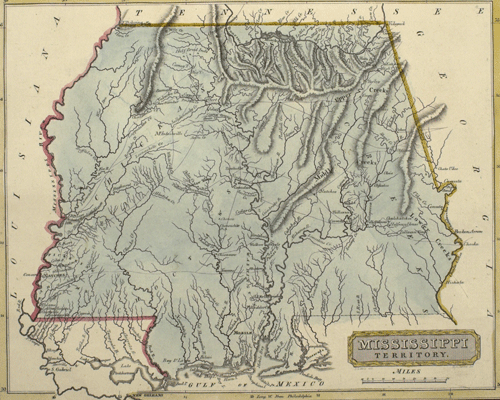Results navigation
2. Alabama 1819 Clerk of the Circuit Court, Limestone County
3. Alabama 1819 Clerk of the Circuit Court, Madison County
4. Alabama 1819 Clerk of the Inferior Court, Cotaco County
5. Alabama 1819 Clerk of the Inferior Court, Limestone County
6. Alabama 1819 Clerk of the Inferior Court, Madison County
7. Alabama 1819 Constitutional Convention, Madison County
8. Alabama 1819 Governor
9. Alabama 1819 House of Representatives, Cotaco County
10. Alabama 1819 House of Representatives, Limestone County
Results navigation

Alabama
Alabama, originally part of Mississippi Territory, became a separate territory in 1817. The formation of Alabama Territory was strongly influenced by a group of Georgia politicians aligned with William Crawford. This Georgia faction, or "Broad River" group, was led by two of Georgia's senators, Charles Tait and William Wyatt Bibb. Both moved west to Alabama where they and other elite Georgians came to be known as the “Royal Party.” Bibb was appointed the first and only territorial governor by President James Madison. The territory's General Assembly, a bicameral body, was relatively weak compared to the governor, as was the case in most federal territories.
In July, 1819 forty-four delegates met in Huntsville to write Alabama’s Constitution to prepare for statehood. They created a bicameral General Assembly divided into a Senate and a House of Representatives. Members of the House served one year terms while members of the Senate served three years. The Governor served two-year terms and was limited to two terms in office. Both members of the General Assembly and the Governor were popularly elected by ballot. The suffrage was restricted to white men over the age of 21 who had resided in the state for at least one year, but there were no property requirements.
The voters of Alabama elected William Wyatt Bibb the first governor of the state where he encountered a more powerful General Assembly than he had been accustomed to in the territorial period. Legislators elected all of the heads of executive departments and they could override gubernatorial vetoes with a simple majority vote.
Formal partisan divisions played almost no role in Alabama's early political history. Because the territory and state were formed during the Era of Good Feelings after the collapse of the Federalist Party through much of the country, most of Alabama’s political leaders and voters claimed allegiance to the Republican majority. Factions in Alabama formed around the Royal Party, the elite settlers with roots in the Broad River region of Georgia, and the politicians who opposed them. Because many of the leaders aligned with the Royal Party were involved in banking in Alabama, the financial collapse associated with the Panic of 1819 sharpened political conflict and gave ammunition to their more populist-oriented opponents. Regional divisions also shaped Alabama’s factionalism, especially as politicians fought over the location of the new state capital. The territorial assembly favored Tuscaloosa, a site far enough north to make it accessible to the residents of the Tennessee Valley. William Wyatt Bibb chose Cahawba instead, a site more closely situated to his political base in central Alabama. The new state assembly accepted that decision but also granted the General Assembly power to select a permanent capital in 1825 without input from the governor. At that time the seat of government shifted to Tuscaloosa, where it remained until moving to Montgomery in the 1840s.
Bibliography and Related Sources
- Alabama Legislative History
- Alabama Department of Archives and History
- Atkins, Leah Rawls, Wayne Flynt, William Warren Rogers, and David Ward.
Alabama: The History of a Deep South State - Dupre, Daniel S. Transforming the Cotton Frontier: Madison County, Alabama, 1800-1840.
Baton Rouge: Louisiana State University Press, 1997. - Owen Thomas M.
History of Alabama and Dictionary of Alabama Biography 4 vols. 1921. - Peirce, Neal R.
The Deep South States of America: People, Politics, and Power in the Seven Deep South States (1974). Information on politics and economics 1960–72. - Rogers, William Warren, et al., eds.
Alabama: The History of a Deep South State. Tuscaloosa: The University of Alabama Press, 1994. - Thorton, J. Mills, III.
Politics and Power in a Slave Society. Baton Rouge: Louisiana State University Press, 1978. - Webb, Samuel L. and Margaret E. Armbrester, eds.
Alabama Governors: A Political History of the State. Tuscaloosa: The University of Alabama Press, 2001.






